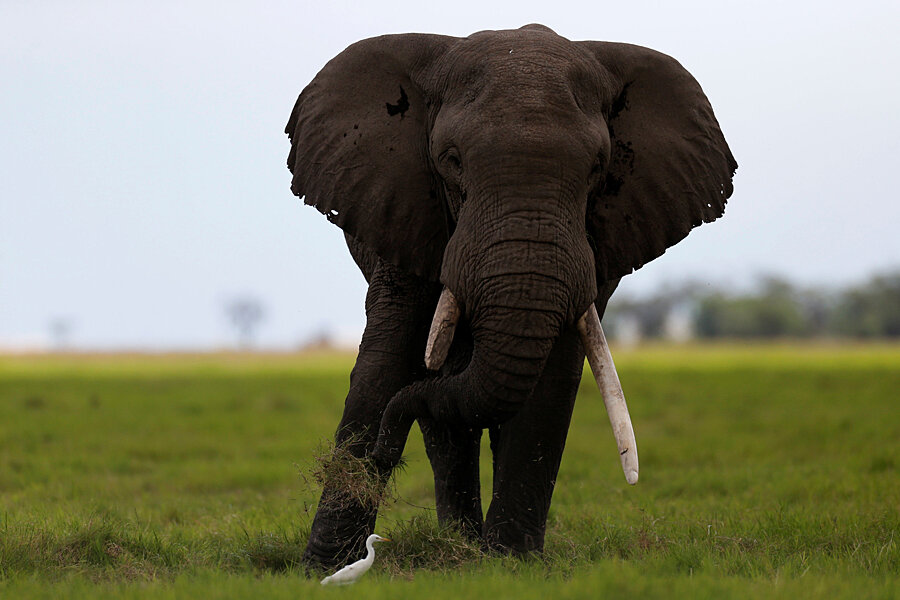Will burning ivory help stop poaching? Kenya says yes.
Loading...
The Kenyan government wants to send a message to poachers and illegal smugglers of ivory. The way they plan to make their point is to set ablaze the largest stockpile of ivory in history, approximately 100 tons of elephant ivory, or 5 percent of the world's ivory.
On April 30th, the president of Kenya, Uhuru Kenyatta, will start the fire at the Nairobi National Park – a controversial anti-poaching strategy that has been opposed by some of the continent's elephant-ranging states, including Botswana and South Africa.
By burning the ivory, Kenya hopes show the world its commitment to ending the ivory trade, a business that has lead to the killing of thousands of elephants. Every year about 20,000 to 35,000 of elephants are poached in Africa, driven by the growing demand for ivory around the globe, especially Asia. In Kenya alone, 164 elephants and 35 rhinos were killed in 2014, a drop from the 302 elephants and 59 rhinos that were killed in 2013.
The ivory burn isn't Kenya's first. It marks the fourth time ivory has been burned, but this is expected to be the largest one ever. The first burning of ivory took place in 1989 when the former president of Kenya, Daniel Arap Moi, set fire to 13 tons of ivory, the same year that the Convention on International Trade in Endangered Species (CITES) initiated an international overhaul on ivory sale.
Following the ban, the number of elephants killed in Kenya went down from thousands a year to around 100 by the end of 1990, Richard Leakey, who headed the Kenya Wildlife Service (KWS) from 1989 to 1994, and who was reinstated to the position in 2015, told Scientific American. Moi’s successor, Mwai Kibaki, also burned about 20 tons in 2009, and the current president Kenyatta conducted his first burn last year.
The upcoming event has drawn a lot of public support, displayed by the thousands of tweets with the hashtag #WorthMoreAlive. Public figures, celebrities and several other Kenyans have been tweeting images of the ivory ahead of the event, calling on the world to join in the support to raise awareness of the elephants that are being targeted. The message they hope to promote is that the value lies with living elephants, not just their ivory.
“Kenya has decided to burn ivory because the moment you burn it, you are making it beyond economic use. Trophy disposal is left for countries to decide, some opt to crush it,” Kenya Wildlife Service director general Kitili Mbathi told the Star.
“My feeling is that many people who are buying this ivory in China and elsewhere simply don’t know what it is doing to elephants,” Leakey told Scientific American. “Maybe they think that it is coming off elephants that have died of natural causes. When Kenya burns $100 million worth of ivory, they’ll say, ‘What the hell was that about?’ It will help open their eyes to what is actually happening.”
The measure has its critics, however, ranging from those who contend that the burning will raise the prices of the commodity, to those who say that such an action demonstrates that elephants aren’t valued. Indeed some of the conservationists opposing the move have warned that it may backfire.
“Kenya is making a mistake, it’s an unwise move,” Mike Norton-Griffiths, a Kenyan ecologist told Bloomberg in an interview. “Taking such a huge resource completely off the market may in turn back the drop in prices.”
Another way to go, say some elephant advocates, would be to sell the stockpile to raise money for conservation. But the Kenyan government argues that putting the ivory on the market, though meant for a good cause, will strengthen the very black market it is seeking to destroy. Mr. Leakey told the Scientific American that the surge in ivory prices in the years after the 1989 ban was partly due to the fact that countries including South Africa, Botswana, Namibia, Zimbabwe put recovered ivory on the market.
Editor's note: This article has been edited to clarify neighboring countries' positions on burning ivory.






